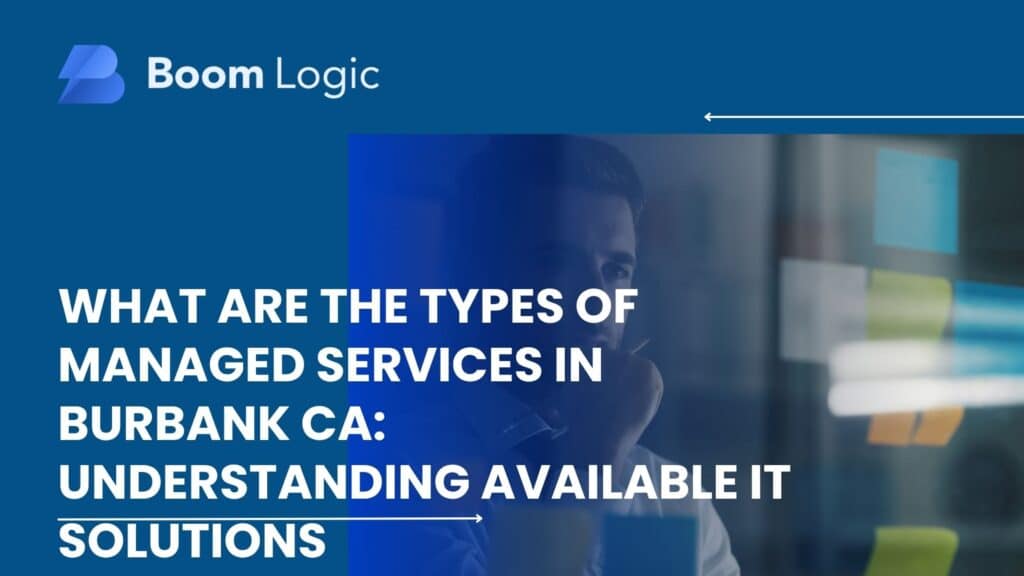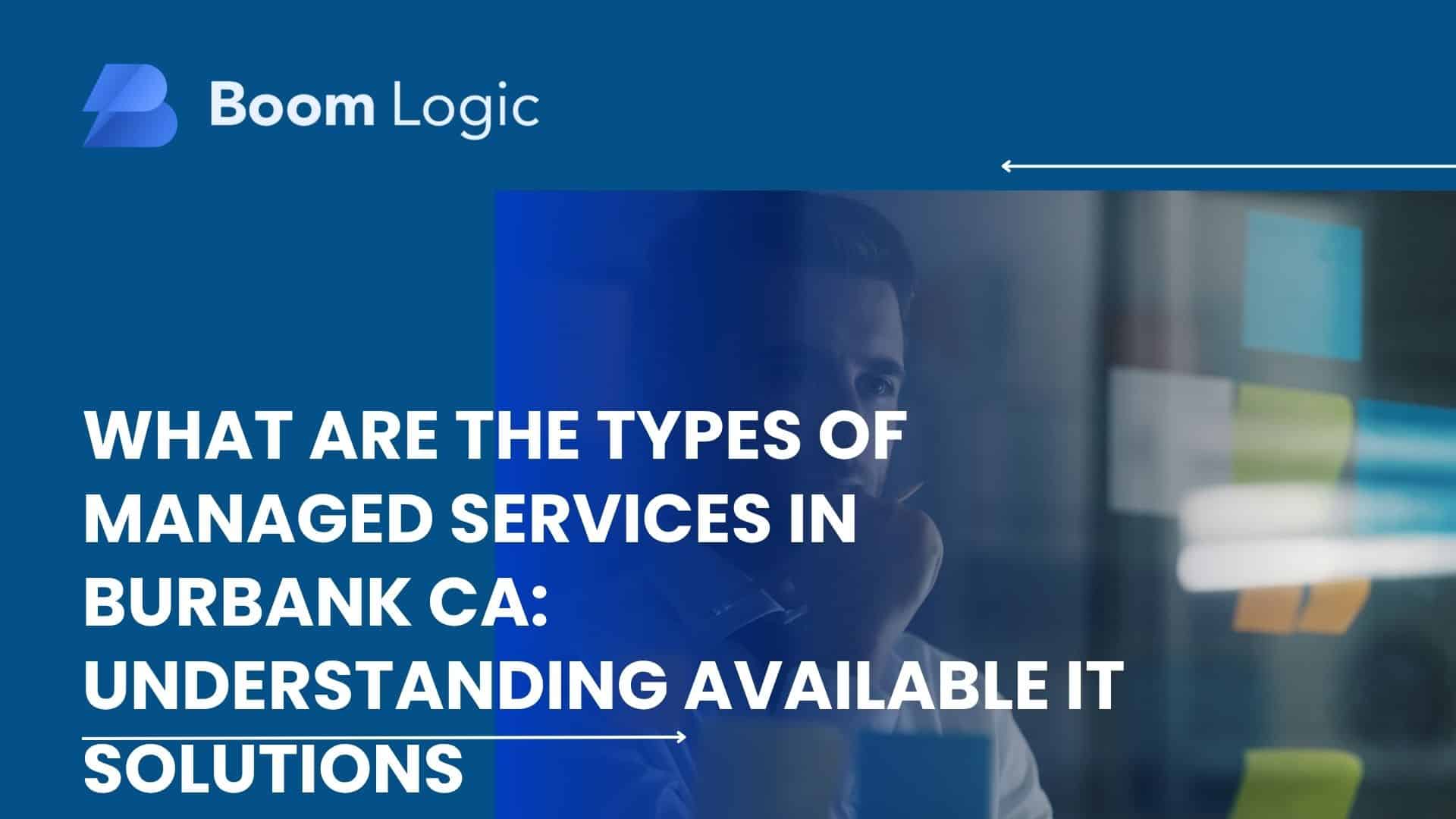
Navigating technology management can feel overwhelming for business owners in Burbank, CA. You’re juggling operations, customer service, and growth strategies—all while trying to keep your IT infrastructure secure and efficient. That’s where managed services come in. Understanding what managed services are and the various types available helps you make informed decisions about your technology investments. Whether you’re a small startup or an established enterprise, knowing your options ensures you select solutions that align with your operational needs and budget.
Key Takeaways
- Managed services provide proactive IT support, reducing downtime and preventing costly technology failures through continuous monitoring and maintenance
- Multiple service types exist, including helpdesk support, cybersecurity, cloud solutions, backup and recovery, and network management—each addressing specific business needs
- Burbank businesses benefit from local expertise, with providers understanding regional compliance requirements, connectivity challenges, and industry-specific demands
- Cost predictability improves planning, as managed services typically operate on fixed monthly fees rather than unpredictable break-fix expenses
- Scalability supports growth, allowing your technology infrastructure to expand seamlessly as your business evolves
- Expertise access becomes affordable, giving small and medium businesses enterprise-level IT capabilities without maintaining full in-house teams
Overview
This comprehensive guide explores the types of managed services available to Burbank businesses, helping you understand how each solution addresses specific operational challenges. We’ll examine core service categories—from helpdesk support and cybersecurity to cloud hosting and disaster recovery—providing clear explanations of what each entails and which business scenarios benefit most. You’ll discover actionable insights into selecting the right managed service provider, understanding service level agreements, and evaluating whether your organization needs a single specialized service or a comprehensive IT management package. Our FAQ section addresses common questions about implementation timelines, cost structures, and transition processes. As a Burbank-based managed service provider, we understand the unique technology challenges facing local businesses and offer solutions designed to keep your operations running smoothly.
Understanding Managed Services Fundamentals
Managed services represent a strategic approach to IT management where you partner with an external provider to handle specific technology functions. Rather than reacting to problems as they occur, this model emphasizes prevention, continuous monitoring, and proactive maintenance. Think of it as having a dedicated IT department focused on keeping your systems healthy, secure, and optimized—without the overhead of hiring, training, and retaining full-time specialists.
The core principle behind managed services involves shifting from a reactive “break-fix” mentality to a proactive management strategy. Traditional IT support waits for something to malfunction before intervening. Managed services continuously monitor your infrastructure, identify potential issues before they cause disruptions, and implement solutions during planned maintenance windows. This approach dramatically reduces unexpected downtime, improves system reliability, and allows you to focus on core business activities rather than technology troubleshooting.
For Burbank businesses specifically, managed services offer particular advantages. The competitive Southern California market demands operational efficiency and minimal downtime. Local providers understand regional considerations like seismic preparedness for data centers, California-specific privacy regulations including the California Consumer Privacy Act, and the connectivity infrastructure available throughout Los Angeles County. This geographical awareness translates into solutions tailored to your actual operating environment.
Helpdesk and Technical Support Services
Helpdesk services form the foundation of most managed service arrangements. This category encompasses all user-facing technical support—the assistance your employees need when technology stops working as expected. A managed helpdesk provides a centralized contact point where staff can report issues, request assistance, and receive guidance on technology questions. The service typically includes ticket management, prioritization based on business impact, and systematic resolution tracking.
Modern helpdesk services extend beyond simple troubleshooting. They include user training, documentation creation, and knowledge base development that helps your team become more self-sufficient with technology. When your employees understand how to resolve common issues independently, they spend less time waiting for support and more time on productive activities. The helpdesk also serves as a valuable feedback mechanism, identifying recurring problems that might indicate deeper infrastructure issues requiring attention.
Response time commitments differentiate quality helpdesk services from mediocre ones. Service level agreements should specify maximum response times for different issue severities. Critical problems affecting multiple users or core business functions demand immediate attention, while lower-priority requests can be addressed within longer timeframes. Understanding these commitments helps you evaluate whether a provider’s service matches your operational requirements. Our outsourced IT helpdesk services provide Burbank businesses with responsive, knowledgeable support that minimizes disruption to daily operations.
Cybersecurity and Threat Protection
Cybersecurity managed services protect your business from the constantly evolving landscape of digital threats. This category includes multiple layers of defense: perimeter security monitoring, endpoint protection, threat detection, vulnerability management, and incident response. Given that cyberattacks increasingly target small and medium businesses—which often lack sophisticated defenses—these services have become essential rather than optional.
A comprehensive cybersecurity approach combines preventive measures with detection and response capabilities. Preventive measures include firewall management, antivirus deployment, email filtering, and access controls that limit who can reach sensitive systems and data. Detection capabilities involve continuous monitoring for suspicious activities, unusual network traffic patterns, and indicators that malicious actors may have penetrated your defenses. Response protocols ensure that when incidents occur, they’re contained quickly to minimize damage.
Security awareness training represents an often-overlooked component of effective cybersecurity. Your employees are simultaneously your greatest vulnerability and your strongest defense. Training helps staff recognize phishing attempts, understand social engineering tactics, follow proper password protocols, and report suspicious activities. Regular training updates ensure your team stays current as attack methods evolve. Many managed security providers include this training as part of their service packages. Explore our cybersecurity solutions to understand how we protect Burbank businesses from digital threats.
Network Management and Monitoring

Network management services ensure your connectivity infrastructure operates reliably and efficiently. Your network forms the backbone connecting all technology resources—servers, workstations, printers, phones, cloud applications, and internet access. When network performance degrades or fails, business productivity grinds to a halt. Managed network services continuously monitor network health, optimize performance, and resolve issues before users notice problems.
These services encompass several technical areas. Configuration management ensures network devices operate with correct, secure settings and receive timely firmware updates. Bandwidth monitoring identifies bottlenecks and helps you understand whether your internet connection meets actual usage demands. Traffic analysis reveals which applications consume the most resources, informing decisions about network upgrades or application optimization. Performance baseline establishment helps identify abnormal patterns that might indicate problems.
Proactive capacity planning prevents network infrastructure from becoming a growth constraint. As your business expands—adding employees, locations, or technology-intensive applications—your network must scale accordingly. Managed network providers analyze usage trends, forecast future requirements, and recommend infrastructure improvements before capacity limitations impact operations. This forward-looking approach costs less than emergency upgrades implemented after performance has already degraded. Learn more about our networking as a service offerings designed to keep Burbank businesses connected.
Cloud Services and Hosted Solutions
Cloud managed services help businesses leverage remote computing resources effectively. Rather than maintaining physical servers in your office, cloud solutions deliver computing power, storage, and applications through internet connections. Managed cloud providers handle the technical complexity—server provisioning, software installation, performance optimization, security hardening, and ongoing maintenance—allowing you to simply use the resources as needed.
Several cloud service models exist, each serving different purposes. Infrastructure as a Service (IaaS) provides virtual servers you can configure as needed. Platform as a Service (PaaS) offers development environments for creating custom applications. Software as a Service (SaaS) delivers complete applications like email, customer relationship management, or accounting software. Managed cloud providers help you navigate these options, selecting the appropriate model for each business function and ensuring seamless integration across your technology ecosystem.
Cost management represents a significant advantage of managed cloud services. Cloud resources operate on consumption-based pricing—you pay for what you actually use rather than maintaining excess capacity for peak demand periods. However, unmanaged cloud environments can generate unexpected costs through resource sprawl or inefficient configurations. Managed providers implement governance policies, monitor resource utilization, optimize configurations for cost efficiency, and provide transparent reporting on cloud expenditures. Our managed cloud server hosting services offer Burbank businesses reliable, cost-effective cloud infrastructure without the management headaches.
Backup and Disaster Recovery
Backup and disaster recovery services protect your business from data loss and extended operational disruptions. Every organization faces potential data loss scenarios—hardware failures, accidental deletions, ransomware attacks, natural disasters, or simple human errors. Without proper backup systems, these events can cause catastrophic business consequences including permanent data loss, regulatory penalties, customer trust erosion, and even business closure.
Effective backup strategies follow the 3-2-1 rule: maintain three copies of data, store them on two different media types, and keep one copy offsite. Managed backup services automate this process, continuously capturing changes to your critical data, encrypting backups for security, and storing copies in geographically separate locations. Regular testing ensures backups can actually be restored when needed—a step many businesses overlook until disaster strikes.
Disaster recovery planning extends beyond data backup to encompass complete operational continuity. Recovery Time Objective (RTO) specifies how quickly you need systems restored after disruption. Recovery Point Objective (RPO) defines how much data loss your business can tolerate. Managed disaster recovery providers design solutions meeting your specific objectives, whether that means maintaining hot failover systems that activate within minutes or implementing less expensive backup restoration processes with longer recovery timeframes. Burbank businesses facing California wildfire risks or earthquake vulnerabilities particularly benefit from robust disaster recovery planning. Discover how our backup and disaster recovery services protect your critical business data.
Security Operations Center (SOC) Services
Security Operations Center services provide 24/7 security monitoring and threat response capabilities. While basic cybersecurity services protect against known threats, SOC services actively hunt for sophisticated attackers who may have evaded initial defenses. This continuous vigilance proves essential as cybercriminals increasingly employ advanced persistent threat tactics designed to remain undetected for extended periods while extracting valuable data.
A SOC team combines specialized tools with human expertise. Security Information and Event Management (SIEM) systems aggregate log data from across your infrastructure, correlating events to identify suspicious patterns. Intrusion detection systems monitor network traffic for known attack signatures. Endpoint detection and response tools track activities on individual devices for malicious behaviors. Security analysts interpret these signals, distinguishing genuine threats from false alarms, and coordinate appropriate responses.
Incident response protocols define how security events are handled. Minor incidents might require simple actions like blocking an IP address or resetting compromised credentials. Major breaches demand coordinated responses including system isolation, forensic investigation, evidence preservation, stakeholder notification, and remediation implementation. Having a managed SOC means these capabilities are available immediately when needed, rather than scrambling to assemble expertise during a crisis. Our 24/7 dedicated SOC team provides Burbank businesses with enterprise-grade security monitoring at affordable rates.
Compliance and Regulatory Management

Compliance managed services help businesses meet industry-specific regulatory requirements. Numerous sectors face mandatory technology standards—healthcare organizations must comply with HIPAA, financial services firms must satisfy various banking regulations, payment processors must meet PCI-DSS requirements, and businesses handling California residents’ data must address state privacy laws. Non-compliance carries serious consequences including substantial fines, legal liability, damaged reputation, and potential business closure.
Compliance management involves multiple technical and procedural elements. Technical controls include data encryption, access logging, security configurations, and vulnerability management meeting regulatory specifications. Documentation requirements necessitate maintaining policies, procedures, training records, and audit trails proving compliance. Regular assessments identify gaps between current practices and regulatory requirements, enabling remediation before official audits occur.
Continuous compliance monitoring recognizes that compliance is ongoing rather than a one-time achievement. Regulatory requirements evolve, technology configurations drift from approved baselines, and staff turnover affects training completion rates. Managed compliance providers implement continuous monitoring systems, alert you to emerging compliance risks, and maintain documentation required for regulatory audits. This proactive approach reduces audit stress and minimizes the risk of costly violations. Learn about our compliance as a service offerings designed to simplify regulatory management for Burbank businesses.
Managed Detection and Response
Managed Detection and Response (MDR) services represent an evolution beyond traditional security monitoring. While basic security tools generate alerts about potential threats, MDR services actively investigate those alerts, determine which represent genuine risks, and execute appropriate responses. This approach addresses alert fatigue—the overwhelming volume of security notifications that causes important warnings to be missed among false positives.
MDR combines advanced technology with security expertise. Artificial intelligence and machine learning algorithms analyze behavioral patterns across your environment, identifying anomalies that might indicate compromise. Threat intelligence feeds provide current information about attack methods, malicious IP addresses, and vulnerability exploits being actively used. Security analysts contextualize automated findings, investigating suspicious activities to determine whether they represent legitimate threats requiring action.
Response automation accelerates threat containment. When an MDR system identifies a confirmed threat, automated playbooks can immediately isolate affected systems, block malicious network traffic, terminate suspicious processes, and collect forensic evidence. This rapid response limits the damage attackers can cause. Human analysts then conduct deeper investigation, identify root causes, and implement comprehensive remediation preventing similar future incidents. For Burbank businesses without dedicated security staff, MDR provides expertise that would otherwise require significant hiring investments.
Virtual CIO and Strategic IT Planning
Virtual Chief Information Officer (vCIO) services provide strategic technology leadership without the cost of a full-time executive. Many small and medium businesses need strategic IT guidance—aligning technology with business objectives, planning infrastructure investments, evaluating new solutions, and preparing for future growth—but cannot justify employing a senior technology executive. Virtual CIO services fill this gap, offering experienced leadership on a part-time or consulting basis.
A vCIO brings multiple perspectives to your business. They understand your specific industry, competitive landscape, and operational challenges. They maintain broad awareness of technology trends, emerging solutions, and best practices across various business sectors. This combination allows them to recommend strategies tailored to your circumstances rather than generic approaches. Regular strategic planning sessions ensure technology decisions support business objectives rather than existing in isolation.
Technology roadmap development translates strategy into actionable plans. Your vCIO helps prioritize competing technology initiatives, sequence implementations logically, budget appropriately for planned investments, and establish metrics measuring technology’s business impact. This structured approach prevents reactive technology spending driven by immediate problems or vendor sales pitches. Instead, each technology decision fits within a coherent plan advancing your business goals. Many Burbank businesses discover that vCIO guidance delivers substantial value through better technology decisions and avoided costly mistakes.
Endpoint Management and Device Support
Endpoint management services oversee all devices connecting to your network—computers, laptops, tablets, smartphones, and increasingly, Internet of Things (IoT) devices like smart displays or security cameras. Each endpoint represents both a productivity tool and a potential security vulnerability. Managed endpoint services ensure devices remain properly configured, securely patched, and compliant with organizational policies.
Device lifecycle management encompasses several stages. Procurement involves selecting appropriate hardware meeting business requirements at optimal prices. Deployment includes initial configuration, software installation, security hardening, and user setup. Ongoing management involves patch deployment, software updates, performance monitoring, and troubleshooting. Retirement ensures devices are properly wiped before disposal and data is securely transferred to replacement equipment.
Mobile device management has become particularly important as remote work increases. Bring Your Own Device (BYOD) policies allow employees to use personal devices for business purposes, creating convenience but introducing security and data governance challenges. Managed endpoint services implement containerization separating personal and business data, enforce security requirements like encryption and screen locks, and enable remote wiping if devices are lost or stolen. This balanced approach supports workforce flexibility while protecting business information.
Application and Software Management
Application management services handle the software your business depends upon daily. Modern businesses utilize numerous applications—email, document creation, customer relationship management, accounting, project management, communication tools, and industry-specific solutions. Each application requires installation, configuration, updates, integration with other systems, user training, and ongoing troubleshooting. Managed application services coordinate these activities, ensuring software operates reliably and users can work productively.
Software licensing represents a significant management challenge. Most commercial applications require licenses for each user or device. License agreements include complex terms regarding permitted usage, upgrade rights, and transfer restrictions. Organizations frequently face either compliance risks from insufficient licenses or wasted spending on unused licenses. Managed providers track license inventory, monitor usage patterns, optimize license allocation, and ensure compliance during software audits.
Integration management ensures your various applications work together seamlessly. Modern business workflows often span multiple systems—customer inquiries captured in a contact form flow to your CRM, generating tasks in your project management tool, with time tracking feeding your accounting system. Managed application providers implement integrations using APIs, middleware platforms, or custom development, creating efficient automated workflows. This reduces manual data entry, minimizes errors, and accelerates business processes. Review how managed IT services work for Burbank businesses to understand comprehensive technology management.
Vendor Management and Coordination
Vendor management services coordinate relationships with your various technology suppliers. Most businesses work with multiple vendors—internet service providers, hardware manufacturers, software publishers, cloud platforms, and specialized service providers. Managing these relationships—tracking contracts, coordinating support requests, negotiating renewals, resolving disputes—consumes significant time and requires technical expertise to evaluate proposals and hold vendors accountable.
A managed service provider often acts as your single point of contact for technology matters. When issues arise spanning multiple vendors—perhaps application performance problems stemming from network connectivity or cloud platform configurations—your managed provider investigates across vendor boundaries, identifies root causes, and coordinates resolution. This eliminates the frustrating finger-pointing common when you contact vendors directly, each blaming others for problems.
Strategic vendor relationship management extends beyond problem resolution. Your managed provider leverages relationships with technology vendors, often obtaining better pricing, priority support access, or early information about new products. They understand vendor capabilities and limitations, helping you select appropriate suppliers for new initiatives. They also maintain vendor accountability, ensuring promised service levels are actually delivered and advocating on your behalf when issues occur. For Burbank businesses juggling multiple technology relationships, this coordination provides substantial value.
Boom Logic, located at 1106 Colorado Blvd., Los Angeles, CA, 90041, has served Burbank businesses for years with comprehensive managed services solutions. Whether you need complete IT management or specific services addressing particular challenges, our team brings local expertise and proven capabilities. You can reach us at +1 833 266 6338 to discuss which types of managed services best fit your business requirements and operational goals.
Common Questions About the Types of Managed Services in Burbank CA
Q: How do I determine which managed services my Burbank business actually needs?
A: Start by assessing your current IT pain points, available internal expertise, and business priorities. If you experience frequent downtime, security concerns, or overwhelmed staff managing technology, those areas indicate service needs. Consider whether your team possesses expertise for specialized functions like cybersecurity or cloud management. Many Burbank businesses begin with core services like helpdesk support and security, then expand to additional services as they recognize value and address other technology challenges.
Q: What’s the typical cost structure for managed services in Burbank?
A: Most managed service providers use monthly subscription pricing based on user count, device count, or service scope. Comprehensive packages covering all IT functions typically range from $100-$250 per user monthly, while specialized services like security monitoring or cloud management may be priced separately. Fixed monthly pricing provides budget predictability compared to unpredictable break-fix expenses. Request detailed proposals from multiple providers to compare offerings and understand exactly what’s included at different price points.
Q: How long does implementing managed services take for a Burbank business?
A: Implementation timelines vary based on service scope and current infrastructure complexity. Basic services like helpdesk support can often begin within days once contracts are signed. Comprehensive infrastructure takeover including network documentation, security assessment, and system optimization typically requires 4-8 weeks. The provider performs discovery, understanding your current environment, then methodically transitions services to minimize business disruption. Well-planned implementations occur in phases, establishing basic support immediately while completing deeper technical work over time.
Q: Can I keep some IT functions in-house while outsourcing others to a managed provider?
A: Absolutely. Many Burbank businesses adopt co-managed IT models retaining internal staff for strategic projects or specialized knowledge while outsourcing routine management, after-hours support, or areas lacking internal expertise. Clear responsibility delineation prevents confusion—document which functions the managed provider handles versus internal team responsibilities. Successful co-managed arrangements require good communication between your staff and the provider, with regular coordination meetings ensuring everyone understands current priorities and projects.
Q: How do managed service providers ensure data security and confidentiality?
A: Reputable providers implement multiple security measures protecting your data. These include background checks for technical staff, non-disclosure agreements, access logging, privileged access management limiting which personnel can reach sensitive systems, and their own security certifications demonstrating compliance with industry standards. Service agreements should specify data protection obligations, security incident notification requirements, and liability terms. Request information about a provider’s security practices, certifications, and insurance coverage before engaging their services.
Q: What happens if I’m dissatisfied with my managed service provider?
A: Quality providers stand behind their work with service level agreements specifying performance commitments and remedies if those commitments aren’t met. Most contracts include termination provisions allowing either party to end the relationship with 30-90 days notice. Before terminating, communicate concerns—many issues can be resolved through honest discussion and process adjustments. If you do transition to a different provider, professional companies facilitate smooth handoffs, providing documentation and cooperation ensuring continuity. Review contract terms carefully before signing, understanding termination provisions and any early cancellation penalties.
Q: Do managed service providers work with existing IT infrastructure or require equipment replacement?
A: Professional providers work with your existing infrastructure, optimizing what you have before recommending replacements. Initial assessments identify equipment that’s secure, performant, and supportable versus components requiring upgrade due to age, security vulnerabilities, or inadequate capacity. They develop prioritized recommendations, focusing investments where they deliver the most value. Many providers help with hardware procurement, leveraging vendor relationships for competitive pricing, but shouldn’t push unnecessary replacements. Focus on providers offering objective guidance aligned with your best interests rather than equipment sales commissions.
Q: How do managed services scale as my Burbank business grows?
A: Quality managed service arrangements scale seamlessly with your business. Adding new employees typically involves simple notification to the provider, who provisions accounts, configures devices, and extends monitoring coverage. Opening new locations, deploying additional applications, or expanding infrastructure follows established processes. Your service agreement should specify how pricing adjusts with growth—usually straightforward per-user or per-device increases. Regular business reviews with your provider ensure technology plans accommodate anticipated growth, preventing infrastructure limitations from constraining expansion. Explore how managed IT scales with business growth to understand this flexibility better.
Conclusion
Understanding the types of managed services available empowers you to make strategic technology decisions supporting your Burbank business objectives. From foundational helpdesk support ensuring productivity to advanced security services protecting against sophisticated threats, managed services provide scalable access to expertise that would otherwise require substantial investment. The right combination of services addresses your specific operational challenges, technology gaps, and growth plans while delivering predictable costs and proactive support.
Taking the next step involves honestly assessing your current technology situation, identifying areas causing problems or constraining growth, and researching providers offering services matching your needs. Don’t feel pressured to implement everything simultaneously—many successful managed service relationships begin with targeted services addressing immediate concerns, then expand over time as value becomes evident and trust develops. The key is selecting a knowledgeable, responsive partner genuinely interested in your success rather than simply selling services. Connect with Boom Logic to explore which types of managed services in Burbank CA align with your business goals and discover how proactive IT management transforms technology from a constant headache into a competitive advantage.


